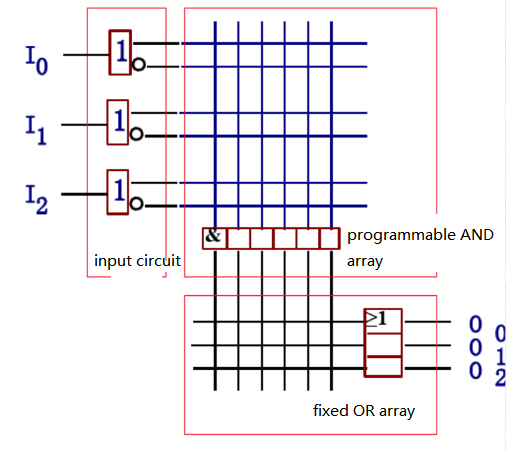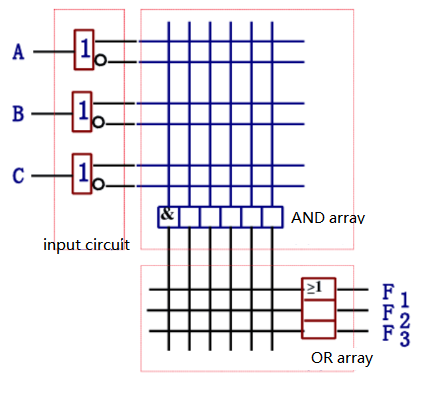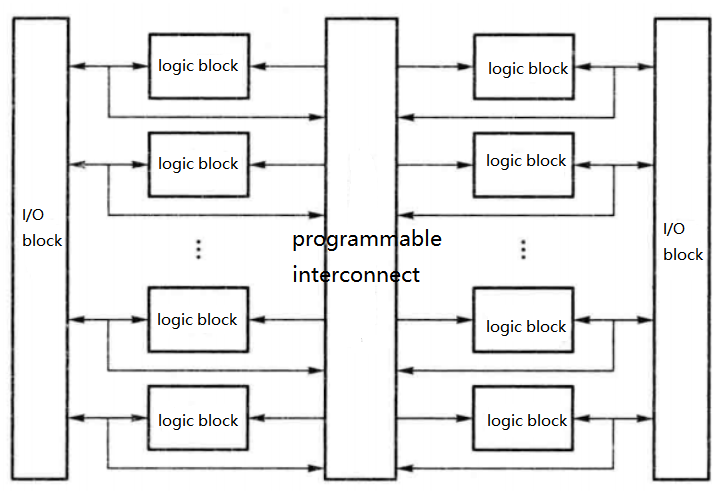A CPLD, or Complex Programmable Logic Device, is a key component in the realm of digital circuit design.
To understand the role of a CPLD, it's important to first understand its counterparts. Simple Programmable Logic Devices (SPLDs), including Programmable Array Logic (PAL), Programmable Logic Array (PLA), and Generic Array Logic (GAL), represent the simplest forms of programmable logic devices. They are perfect for implementing straightforward digital logic designs.
-PAL (Programmable Array Logic): A PAL device consists of two main components. First is a programmable AND gate array, which allows for the creation of different AND gate combinations. This is followed by a fixed OR gate array, which collects the outputs from the AND gate array. This structure allows for the creation of sum-of-products logic expressions. PAL devices offer less flexibility compared to PLAs. However, this also makes them simpler and faster to program.

Figure 1: PAL block diagram
-PLA (Programmable Logic Array): A PLA device also consists of two main components, but unlike a PAL, both the AND and OR gate arrays in a PLA are programmable. This means that a PLA can generate more complex combinations of logic functions, as both the AND and OR gate combinations can be customized. This additional flexibility makes PLA devices more versatile in creating a variety of logic functions. The fully programmable structure of PLAs offers more flexibility than PALs, allowing for the implementation of more complex logic functions.
 Figure 2: PLA block diagram
Figure 2: PLA block diagram
-GAL (Generic Array Logic): Similar to PAL but erasable and reprogrammable.
On the other end of the spectrum, we have Field-Programmable Gate Arrays (FPGAs). FPGAs offer the most complexity and the highest logic capacity among these devices. They are essentially an array of configurable logic blocks connected via programmable interconnects, allowing for the implementation of highly complex digital circuits, including processors and system-level designs.
Situated between SPLDs and FPGAs, we find CPLDs. CPLDs are larger and more complex than SPLDs, yet not as complex as FPGAs. They consist of multiple SPLDs, or macro cells, interconnected through a programmable interconnect matrix. This configuration allows CPLDs to handle more complex designs than SPLDs while maintaining a more predictable timing performance compared to FPGAs, making them a popular choice for moderate-complexity digital logic designs.
In essence, a CPLD leverages the simplicity of SPLDs and the high capacity of FPGAs, thereby serving as a bridge that fills the gap between these two types of programmable logic devices.
CPLD introduction
A CPLD, or Complex Programmable Logic Device, is a type of programmable logic device used in the field of digital design. It serves as an optimal solution for implementing digital circuits and offers a higher capacity for logic complexity than Simple Programmable Logic Devices (SPLDs).
CPLDs are made up of multiple programmable logic blocks, often referred to as macro cells, interconnected by a programmable interconnect matrix. Each macro cell can be programmed to perform a specific logic function, and the programmable interconnect matrix allows these macro cells to be interconnected in various ways to perform more complex logic functions.
CPLDs offer a versatile solution for digital design tasks and are particularly useful when a design requires specific, predictable timing characteristics due to their inherent structure. They are widely used in a variety of applications, including digital signal processing, control systems, and data acquisition systems.
CPLD Architecture
The Complex Programmable Logic Device (CPLD) is developed from the PAL (Programmable Array Logic) and GAL (Generic Array Logic) devices. It consists of several programmable logic blocks, which are also called Macrocells. Each macro unit can be programmed independently to perform a specific logical function. These macro units are connected through a programmable interconnection matrix that allows the macro units to interconnect in a variety of ways to implement more complex logic functions. As a result, CPLD combines the advantages of PAL and GAL to provide greater logical complexity and flexibility.

Figure 3: CPLD block diagram
CPLD Applications
- Digital Signal Processing: CPLDs can be used to implement filters, modulators, and other digital signal processing functions.
- Control Systems: CPLDs are often used in control systems where predictable timing and high performance are critical. This includes industrial control systems, automotive systems, and robotics.
- Data Acquisition: In data acquisition systems, CPLDs can be used to control the timing and synchronization of data collection, as well as to preprocess the collected data.
- Communication Systems: CPLDs can be used in communication systems to implement encoding/decoding, error detection and correction, and signal conversion functions.
- Test and Measurement Equipment: CPLDs are used in test and measurement equipment to control the operation of the equipment and process the measurement data.
- Video and Image Processing: CPLDs can be used to implement real-time video and image processing functions, such as color space conversion, image scaling, and video encoding/decoding.
- Prototyping: Due to their reprogrammable nature, CPLDs are often used for prototyping digital circuits before they are implemented in more permanent form, such as in an ASIC (Application-Specific Integrated Circuit).
CPLD in VLSI: A concrete example of the application of CPLD in practical circuit design
CPLDs (Complex Programmable Logic Devices) play a crucial role in the field of VLSI (Very-Large-Scale Integration), which involves integrating thousands to millions of transistors into a single chip.
Suppose we are designing a digital system that involves a variety of digital components such as counters, decoders, multiplexers, and memory units. This system might be for a specific application like a traffic light controller, a digital clock, or a part of a larger system like a microprocessor.
Instead of using individual chips for each of these components and manually wiring them together, we can use a CPLD. The CPLD can be programmed to integrate all these digital components into a single chip, significantly reducing the complexity of the circuit design, increasing reliability, and saving board space.
Furthermore, using a CPLD allows us to easily modify the design or correct errors by simply reprogramming the CPLD, without the need for changing the hardware. This not only saves time and cost but also makes the design highly flexible and adaptable.
These are just a few examples of the many possible applications of CPLDs. The flexibility and programmability of CPLDs make them a useful tool in many areas of digital electronics and digital systems design.
CPLD family
CPLDs (Complex Programmable Logic Devices) are produced by various manufacturers, each offering their own families of devices with different features, capacities, and characteristics. Here are some of the major CPLD manufacturers and their respective CPLD families:
- Xilinx: One of the leading manufacturers of programmable logic devices. Xilinx's CPLD families include the XC9500, XC9500XL, and XC9500XV series, and the CoolRunner-II series.
- Intel (formerly Altera): Another major manufacturer of programmable logic devices. Intel's CPLD families include the MAX 3000A, MAX II, MAX V, and MAX 10 series.
- Lattice Semiconductor: Lattice offers several families of CPLDs, including the ispMACH 4000 and MachXO series.
- Microchip (formerly Atmel): Microchip's CPLD families include the ATF1500 series.
Each family of CPLDs has its own unique features and advantages, and the choice of CPLD often depends on the specific requirements of the digital design, such as logic capacity, power consumption, operating speed, and cost.
CPLD features
- High Density: CPLDs typically consist of numerous logic gates, making them suitable for implementing complex digital circuits.
- Predictable Timing: Unlike FPGAs, CPLDs have predictable timing characteristics. This makes them ideal for designs that require precise control over logic operations.
- Non-Volatile: CPLDs are non-volatile, meaning they retain their programming even when power is removed. This allows them to start up instantly, unlike FPGAs which need to load their configuration at startup.
- Reprogrammable: CPLDs are reprogrammable, allowing for design changes or updates without the need for new hardware.
- Low Power Consumption: CPLDs generally consume less power than FPGAs, especially in standby mode.
- Integration: CPLDs can integrate several discrete logic chips into one device, reducing board space and increasing reliability.
- Security: CPLDs offer design security features that prevent unauthorized copying of the device configuration.
- Wide Range of Package Options: CPLDs are available in a wide range of packages to suit different application requirements.
CPLD vs FPGA: Comparison between CPLD and FPGA
Logic Density: FPGAs generally have a higher logic density and can accommodate more complex or larger designs than CPLDs.
Speed: CPLDs have predictable timing characteristics and can often operate at higher speeds than FPGAs.
Power Consumption: CPLDs typically consume less power in standby mode compared to FPGAs, making them a better choice for low power applications.
Programmability: FPGAs are more flexible in terms of programmability because they have a larger number of smaller logic blocks that can be configured in different ways. CPLDs, on the other hand, have fewer, but larger logic blocks (macro cells).
Cost: CPLDs are generally less expensive than FPGAs, especially for smaller designs.
Startup Time: CPLDs have almost instantaneous startup time, while FPGAs may require a few milliseconds to load their configuration from an external memory.
Volatility: CPLDs are non-volatile, meaning they retain their configuration even without power, while most FPGAs are volatile and need to be reprogrammed at startup.











Comments
0 Comments